
When Dustin Kott turns his hand to a CB, you can be sure it’s going to
come out special. The Californian builder has favored Hondas since he
first popped up on the scene—and to call him a specialist would now be
something of an understatement.
When we contacted Kott
about his latest project, he sent back photos of no less than three
CBs. This one was our favorite—a classy ’74-model CB550 with a vintage
café racer flavor, dubbed the ‘Exec 550.’

At the core of the build is a CB750 Super Sport fuel tank, enhanced with
knee and steering indents and a tidier filler cap. Kott is a master
metal shaper and hand-built tail pieces are a signature of his. This one
was fashioned from round bar and sheet steel to complement the tank.

Once the frame was modified to accept the new tank and seat, it was
stripped and given a glossy clear coat, resulting in a golden grey
finish. This monochromatic feel was carried through to the rest of the
build, punctuated by some tasteful brass bits.
These include plated mesh steel inserts on the tailpiece and rear
hub. Kott also hand-cut brass mounting plates for the rearsets, which he
made using the stock Honda brake and shift levers.
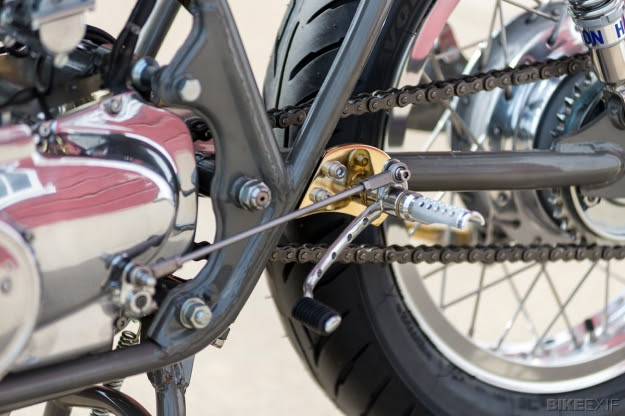
The CB’s engine received a full rebuild, maintaining its stock
displacement of 544cc. The carbs were restored too, and re-jetted to
accommodate velocity stacks. These are tucked away safely behind a
clever, removable brass splash plate. Stainless steel four-into-one
headers and a custom-made muffler were added for a performance boost.
Braking was enhanced via an additional drilled rotor up front. The
fork tubes were then reversed so that dual trailing calipers could be
installed. For a new wheelset, Excel shouldered aluminum rims (19” at
the front and 18” at the rear) were laced with stainless steel spokes
and wrapped in Avon tires, giving “the bottom half of the motorcycle a
stout and sturdy look.” Thanks to new fork internals and Hagon shocks,
the bike is better sprung now as well.
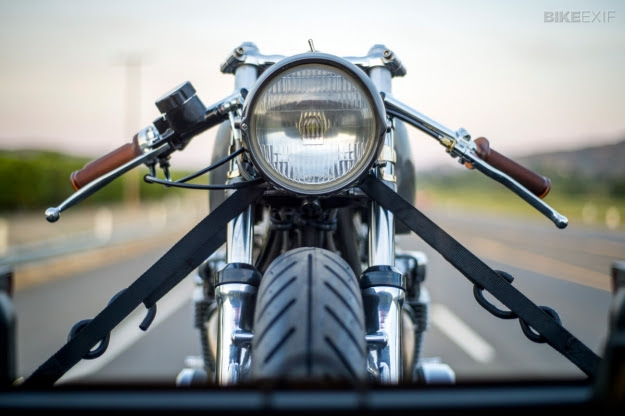
The electronics also got some attention: there’s a four-cell battery
hiding in the seat cowl, and the bike’s been completely rewired with
solid state components and a LED tail light. A ’60s-era pressed steel
Honda headlight was fitted, the same type that you’d find on a SL350 of
that vintage.
Once complete, the Exec 550 was presented at the annual Quail
Gathering. According to Kott, it “was received as a relevant, timeless,
and influential machine.”
Sounds about right. Head over to the Kott Motorcycles website to see more of Dustin Kott’s super-classy builds.
 The post Dustin Kott’s CB550 cafe racer appeared first on Bike EXIF.
The post Dustin Kott’s CB550 cafe racer appeared first on Bike EXIF.

I’m surprised we don’t see more KTMs on the custom scene. Maybe it’s
because the Austrian bikes offer great performance straight out of the
box, and a love-it-or-hate-it style that’s hard to tweak.
Roland Sands
is a fan of the brand, and also one of the few customizers brave enough
to tear down a KTM. In this case, it’s an Enduro 690 given a dash of
tracker style. This is Sands’ second tilt at the 690; regular readers
will remember his café’d version from a few months ago.

What’s so special about the 690? “It’s a great street-able single,” says
Sands. “There’s enough torque to put a smile on your face, but it’s
tame enough to inspire confidence when pushing towards the edge.”
The RSD tracker is lithe and angular, with an almost insect-like
grace. It’s a pretty heavy-duty build, with a new subframe and swingarm
custom-fabricated in airfoil-shaped tubing that matches the existing
frame of the bike.

The bodywork is also hand-formed, this time in aluminum, with sublime
paint from Airtrix. The exhaust system, with ten sections of pipe neatly
bent and welded together, terminates in a stubby, low-slung muffler.

The bike rolls on RSD’s own Del Mar wheels in ‘Contrast Ops’ finish—a
classic dirt track-inspired design. (It’s also the lightest wheel in the
RSD catalog.) The Goodyear/Dunlop flat track rubber is equally
eye-catching, and a Performance Machine brake system hauls the whole
shebang to a stop.

With warm grey-brown powder on the frame and anodizing from show bike
specialists Sport Chrome, the KTM tracker looks a million dollars. Hit
the RSD website for more shots—and a video showing the making (and attempted breaking) of the bike.
 The post KTM Tracker by Roland Sands appeared first on Bike EXIF.
The post KTM Tracker by Roland Sands appeared first on Bike EXIF.
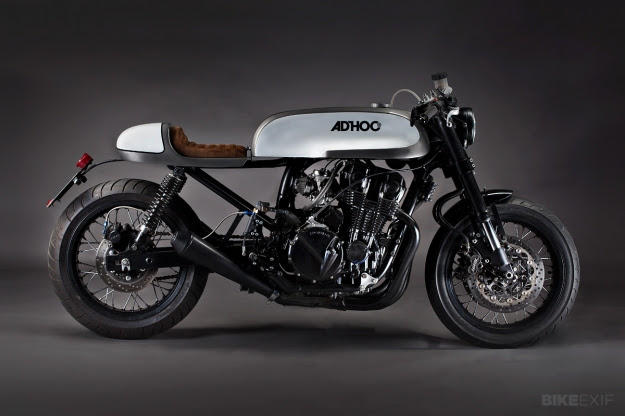
Right now, the epicenter of the European custom scene is Spain. The
Iberian Peninsula is already famous for its petrolhead culture, which
has spawned legions of MotoGP stars—and we’re now seeing a growing
number of workshops transforming older bikes into drop-dead gorgeous
traffic stoppers.
Shops like Café Racer Dreams, Kiddo, Macco Motors, Valtoron and El
Solitario are pushing the custom envelope in different and refreshing
ways. A relative newcomer to the gang is Ad Hoc, the nom de plume of David Gonzalez—creator of this stylish Honda 750 Nighthawk.

Gonzalez’ trick is to pick solid but somewhat clunky bikes, and give
them a touch of class. This Nighthawk was his second build and until now
has flown under the rader, being the the ‘shop bike’ until a customer
took a fancy to it.
After a repaint, Gonzalez has just waved the bike
goodbye.
The Nighthawk 750 is the classic Universal Japanese Motorcycle:
functional, well engineered and slightly dowdy. So Gonzalez retained
just the engine and the central section of the chassis. The handling has
been upgraded via forks from a Suzuki GSX-R750 and the wheels from a
Ducati GT1000.

Gonzalez sandblasted and repainted the frame before hooking it up to a
new swingarm and subframe. Sitting up top is a long, squared-off tank
from Europlast, molded in the endurance racer style. The seat is a
modified Bultaco TSS item, retrimmed in brown nappa leather and the
perfect match for the angular bodywork—a signature of Ad Hoc’s style.
There is rarely anything wrong with the engine of a Nighthawk, which
makes an ample 75 hp. So Gonzalez has simply refreshed it, restored the
stock header pipes, and hooked them up to slim custom mufflers.

Finished in white, metallic grey and black, Ad Hoc #2 has an understated
but classy style. And best of all, it’ll probably keep going forever.
Images by Mónica Doallo. Check out the Ad Hoc website and Facebook page to see more of David Gonzalez’ work.
The post Honda 750 Nighthawk by Ad Hoc appeared first on Bike EXIF.
It’s one thing to talk about the ‘enduring appeal’ of a motorcycle.
It’s quite another for that appeal to translate into solid showroom
sales, year after year.
There are a handful of bikes that have stayed in production for
decades, essentially unchanged—Royal Enfields and Urals spring to mind.
But the king of that particular hill is the Yamaha SR400, a bike that
has been punching above its weight for over 35 years.
Not surprisingly, there’s a huge array of aftermarket parts available
for the SR400. It’s a mainstay of the thriving Japanese custom scene,
and it’s now available again in the USA—this
time with fuel injection. If you’re tempted to lay down some cash for a
new model, or even dig out a secondhand one, take some inspiration from
these five great recent builds.
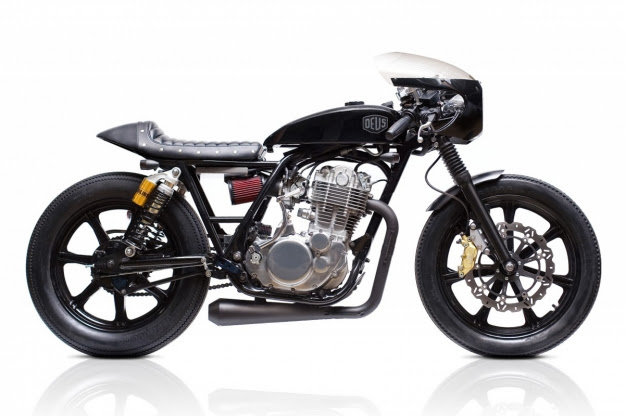 Deus Grevious Angel Outside Japan, the Australian
company Deus is probably the greatest exponent of the custom Yamaha
SR400. ‘Grevious Angel’ is one of Deus’ signature builds, with looks
that have scored it a place in Sydney’s Powerhouse museum. This SR400 is
sporting a tweaked frame, an alloy bullet-style fairing, beadblasted
engine cases, a CV carb and a K&N intake kit. The tank and ducktail
seat unit are from the legendary Japanese brand Nitroheads, and the
tires are classic Avon Speedmasters. Fans of Top Gear take note: James
May has one of these in his garage. [Deus Customs]
Deus Grevious Angel Outside Japan, the Australian
company Deus is probably the greatest exponent of the custom Yamaha
SR400. ‘Grevious Angel’ is one of Deus’ signature builds, with looks
that have scored it a place in Sydney’s Powerhouse museum. This SR400 is
sporting a tweaked frame, an alloy bullet-style fairing, beadblasted
engine cases, a CV carb and a K&N intake kit. The tank and ducktail
seat unit are from the legendary Japanese brand Nitroheads, and the
tires are classic Avon Speedmasters. Fans of Top Gear take note: James
May has one of these in his garage. [Deus Customs]
 Skull Motor Cycle No.19 With so many custom SR400s
around, it’s hard to find one that’s truly different. This machine from a
little-known Japanese workshop fits the bill, with radical hub-center
steering and a pair of shocks tucked under the custom seat unit. The
tank is from a Honda Dream 50 and the lovely pipe is from an XS650.
Hiroshima-based Skull built this machine a couple of years ago as a
showcase for their fabrication skills, and not surprisingly, it whipped
the Japanese custom scene into a frenzy. [More about this bike | sr400times.com]
Skull Motor Cycle No.19 With so many custom SR400s
around, it’s hard to find one that’s truly different. This machine from a
little-known Japanese workshop fits the bill, with radical hub-center
steering and a pair of shocks tucked under the custom seat unit. The
tank is from a Honda Dream 50 and the lovely pipe is from an XS650.
Hiroshima-based Skull built this machine a couple of years ago as a
showcase for their fabrication skills, and not surprisingly, it whipped
the Japanese custom scene into a frenzy. [More about this bike | sr400times.com]
 Gasoline Customs ‘Tomahawk’ Sometimes simple is
best—especially if you’re after a daily rider, a role the SR400 fulfils
admirably. We’re back to Australia for our third choice, this time to
East Sydney’s Gasoline Customs, a workshop of some 20 years’ standing.
There’s no rocket science in this build, but it’s beautifully
judged—from the powdercoated XS650 wheels and brake rotors to the
reworked frame and minimalist tail unit. The exhaust system is as simple
as it gets, but adds to the industrial vibe of the machine. The tires,
in case you’re wondering, are Shinkos originally designed for trials
use. [Gasoline Customs]
Gasoline Customs ‘Tomahawk’ Sometimes simple is
best—especially if you’re after a daily rider, a role the SR400 fulfils
admirably. We’re back to Australia for our third choice, this time to
East Sydney’s Gasoline Customs, a workshop of some 20 years’ standing.
There’s no rocket science in this build, but it’s beautifully
judged—from the powdercoated XS650 wheels and brake rotors to the
reworked frame and minimalist tail unit. The exhaust system is as simple
as it gets, but adds to the industrial vibe of the machine. The tires,
in case you’re wondering, are Shinkos originally designed for trials
use. [Gasoline Customs]
 Motor Rock SR400 #5 There’s relatively little ‘formula’
in Japanese custom building, compared to the West. You’ll often see the
top workshops building a Kawasaki bobber one week, a Triumph café racer
the next, and a Harley with skyscraper-high ape bars the week after
that. Motor Rock of Nagoya is one such shop. Since opening for business
ten years ago, they’ve built 20 Yamaha-based customs—most of them
super-clean SR400s. Like many Japanese bikes, this one looks a little
off-kilter to Western eyes. But it has a strangely appealing charm:
there’s a hint of bobber styling at the back end, and a touch of café
bike at the front. The detailing is beautiful, and the paint on the tank
is to die for. [Motor Rock]
Motor Rock SR400 #5 There’s relatively little ‘formula’
in Japanese custom building, compared to the West. You’ll often see the
top workshops building a Kawasaki bobber one week, a Triumph café racer
the next, and a Harley with skyscraper-high ape bars the week after
that. Motor Rock of Nagoya is one such shop. Since opening for business
ten years ago, they’ve built 20 Yamaha-based customs—most of them
super-clean SR400s. Like many Japanese bikes, this one looks a little
off-kilter to Western eyes. But it has a strangely appealing charm:
there’s a hint of bobber styling at the back end, and a touch of café
bike at the front. The detailing is beautiful, and the paint on the tank
is to die for. [Motor Rock]
 Boogie Single Racer SR400 At last year’s EICMA motor
show in Milan, Yamaha Europe caused a splash by showcasing three ‘Yard
Built’ customs. One came from the Wrenchmonkees, one came from Deus
Milan, and one came all the way from Japan itself. ‘Boogie Single Racer’
was built by one of Tokyo’s top customizers—who officially remained
nameless—and just drips with style. The forks are vintage Ceriani, the
tank is immaculately cut-and-shut, and the rear frame loop isn’t simply
chopped and tucked under the seat—it curves over the outside of the
custom rear fender. There’s a vintage Honda drum brake up front and
delicate filigree carving on much of the bare metal, including the wheel
rims. Pure class. [More about this bike | Yamaha Yard Built Specials]
Last week’s Top 5 covered vintage Triumph hardtails.
The post Top 5 Yamaha SR400 appeared first on Bike EXIF.
Boogie Single Racer SR400 At last year’s EICMA motor
show in Milan, Yamaha Europe caused a splash by showcasing three ‘Yard
Built’ customs. One came from the Wrenchmonkees, one came from Deus
Milan, and one came all the way from Japan itself. ‘Boogie Single Racer’
was built by one of Tokyo’s top customizers—who officially remained
nameless—and just drips with style. The forks are vintage Ceriani, the
tank is immaculately cut-and-shut, and the rear frame loop isn’t simply
chopped and tucked under the seat—it curves over the outside of the
custom rear fender. There’s a vintage Honda drum brake up front and
delicate filigree carving on much of the bare metal, including the wheel
rims. Pure class. [More about this bike | Yamaha Yard Built Specials]
Last week’s Top 5 covered vintage Triumph hardtails.
The post Top 5 Yamaha SR400 appeared first on Bike EXIF.

Success can be both a blessing and a curse. While a well-received build
can put a custom shop on the map, it can just as easily lock them into a
certain style. Not ideal in an industry where progression is key.
This is the position that Jose and Tito of Maccomotors found
themselves in not too long ago. A previous Bonneville they’d
built—dubbed Dusty Pearl—had
garnered such interest that they were receiving numerous requests for a
remake. One such brief came from a client in London, but the Spanish
duo “believe that every bike must be unique and exclusive.” So they
convinced their client to let them build something in a similar vein,
but different.

“The idea was to create a comfortable, stylish Triumph,” says Jose, “but
rude at the same time.” Starting with a 2009 Triumph Bonneville T100,
Macco aimed to mix performance and style while still maintaining “the
essence of the bike.”
In the Málaga workshop, the Bonneville T100′s tank was redone in a
matte black and raw metal scheme—designed to emphasize its muscularity.
Macco shortened and looped the subframe, adding a custom-made, two-up
brown synthetic leather seat. A Thruxton rear fender was bobbed and
fitted, and a fiberglass front fender manufactured in-house.

Macco modified the stock side covers with mesh-lined cutouts, but left
the original chromed engine covers untouched—as they liked the look and
considered them a distinguishing feature of the Bonneville T100. Up
front, 1” Biltwell Tracker bars were fitted, along with Biltwell
Thruster grips, racing-style levers and a mini-speedo. The headlight is a
Bates unit, with a grill borrowed from a Triumph TR6 (of the
four-wheeled variety).

Hagon Nitro shocks (rear) and progressive springs (front) make for a smoother ride, and the wheels are now wrapped in Metzeler
Tourance tires—designed for light dual-sport use with a clear bias
towards tarmac. K&N filters and blacked-out British Customs Predator
exhausts help the T100 breathe a little easier. Other bits include a
LSL sprocket cover, mini turn signals and taillight, and alloy foot
pegs.

While it might share Dusty Pearl’s genes, The Lizard King (as Macco have
named it) is unique enough to keep both its owner and its creators
happy.
All that remains to be seen now is: how many customers will ask Jose and Tito to build another one?
Photos by Sergio Ibarra. Check out Maccomotors’ other bikes on their new website, and keep in touch via the Maccomotors Facebook page.
 The post Bonneville T100 by Maccomotors appeared first on Bike EXIF.
The post Bonneville T100 by Maccomotors appeared first on Bike EXIF.

I have to admit that I’m immune to the charms of modern-day motocross
bikes. I have a soft spot for the old Husky 400s and Honda Elsinores,
but the garish, logo-emblazoned machines of today leave me cold.
There’s no question about their performance, though. And there’s
something magical about riding a bike that weighs less than 250 pounds.
So I like the idea of taking a dirtbike, stripping off the plastic and
stickers, and turning it into a classy roadburner.

I’m guessing Joey Subrizi was thinking along the same lines when he
built this amazing Yamaha YZF 426-based custom. The early 2000s YZF was a
perky four-stroke single with nondescript styling, but had around 45 hp
pushing only 230 lbs around. So Joey has kept the bike’s strengths but
given it an amazing dose of style.
The frame is all-new from the tank backwards. And that tank is an
inspired choice: It’s from a 1976 Yamaha XS360, and matched to a tiny,
waspish tail unit. The frame, swingarm and part of the tank have been
powdercoated in shades of grey and black, with gold trim providing
subtle highlights.

Joey works for Öhlins USA, so there’s a trick gold shock out back. The
original swingarm linkage is gone, and the shock is now a direct
mount—“I don’t need eight inches of travel,” Joey notes.
The forks have been lowered a little from the typical skyscraper
heights of motocross bikes, and compact raw metal guards add a touch of
steampunk—along with the peak over the headlight. The engine is now
blacked-out, and the brightest element of the whole bike is the
hand-made exhaust system.

So it looks sharp, goes fast, and doesn’t cost a bomb to run. What’s not to like?
Images © Frank Bott. Check out his website and Facebook page for more fine motorcycle photography.
 The post Joey Subrizi’s roadgoing YZF 426 appeared first on Bike EXIF.
The post Joey Subrizi’s roadgoing YZF 426 appeared first on Bike EXIF.
If there’s one style of custom motorcycle that’s always been popular,
it’s the mighty hardtail. Reminiscent of the board and dirt trackers of
old, the distinct profile of a hardtail, coupled with the simplicity (or
impracticality) that comes with a lack of rear suspension, holds a
certain charm for many.
While we’ve seen fantastic examples spanning many makes and models,
few evoke as much emotion as those built around British engines of the
1960s and 1970s. So, for today’s selection, we’ve decided to focus our
attention on vintage Triumphs.
These are our five favorite vintage Triumph hardtails—a rather
eclectic mix of styles, so let us know if you agree with our choices.
 Falcon Motorcycles Kestrel This was the second motorcycle in builder Ian Barry‘s
‘Concept 10′ series. At its heart is a 1970 Bonneville engine, which
originally came with a damaged gearbox. Ian cut the unit-engine in half,
ripped out the damaged transmission and installed the gearbox from a
BSA A10. He then re-shaped the engine’s contours by aluminum welding new
pieces and fitting them using a jig, and CNC machined new 750cc
cylinders out of aircraft-grade aluminum.
Only ten inches of the original frame remains; the rest was
fabricated from high-tensile steel tubing and set in a custom-made
aluminum jig, to ensure accurate geometry and flawless alignment. In
fact, most of the Kestrel was created in-house from scratch—from the
girder forks right down to the gas and oil tanks, exhausts, handlebars,
seat, levers and fender.
The Kestrel made its début at the 2010 Quail Motorcycle Gathering in
Carmel, California, in racing trim—the lights and license plate removed
in preparation for racing at El Mirage. It promptly won the award for
‘Best Custom Motorcycle.’ [More about this bike | Falcon Motorcycles]
Falcon Motorcycles Kestrel This was the second motorcycle in builder Ian Barry‘s
‘Concept 10′ series. At its heart is a 1970 Bonneville engine, which
originally came with a damaged gearbox. Ian cut the unit-engine in half,
ripped out the damaged transmission and installed the gearbox from a
BSA A10. He then re-shaped the engine’s contours by aluminum welding new
pieces and fitting them using a jig, and CNC machined new 750cc
cylinders out of aircraft-grade aluminum.
Only ten inches of the original frame remains; the rest was
fabricated from high-tensile steel tubing and set in a custom-made
aluminum jig, to ensure accurate geometry and flawless alignment. In
fact, most of the Kestrel was created in-house from scratch—from the
girder forks right down to the gas and oil tanks, exhausts, handlebars,
seat, levers and fender.
The Kestrel made its début at the 2010 Quail Motorcycle Gathering in
Carmel, California, in racing trim—the lights and license plate removed
in preparation for racing at El Mirage. It promptly won the award for
‘Best Custom Motorcycle.’ [More about this bike | Falcon Motorcycles]
 Analog Motorcycles T120 ‘El Matador’ This T120
Bonneville is what happens when a respected builder creates a bike for
himself. ‘El Matador’ was a two-year labor of love for its owner—Tony
Prust of Analog Motorcycles.
The basis of the build is a 1968 Triumph frame with a Dave Bird
bolt-on hardtail. It’s powered by a 1972-spec 650cc T120 motor, rebuilt
by Ed Zender of Triumph specialists Morrie’s Place and powder coated
wrinkle black. Mods include Maund velocity stacks, pipes from Lowbrow Customs
and a belt drive primary from Bob Newby Racing, with an open cover
designed by Tony and Ed. The forks are from a late ’60s BSA, hooked up
to a twin leading shoe hub laced to a 19” rim. The rear rim is a 16”
Harley unit on a conical hub, and the tyres are dual-sport Kenda K761s. A
full rewire was done on the bike, with a new Joe Hunt magneto installed
as well.
It’s an elegant build, with a hint of steampunk via tasteful brass
touches—including the oil plumbing, tank badges, grips, lights and a
brass rear fender from 7 Metal West. The final finish is raw metal
adorned with gold leaf, pinstriping and a luscious clear coat, done by
Brando Custom Paint. [More about this bike | Analog Motorcycles]
Image by Biker Pros.
Analog Motorcycles T120 ‘El Matador’ This T120
Bonneville is what happens when a respected builder creates a bike for
himself. ‘El Matador’ was a two-year labor of love for its owner—Tony
Prust of Analog Motorcycles.
The basis of the build is a 1968 Triumph frame with a Dave Bird
bolt-on hardtail. It’s powered by a 1972-spec 650cc T120 motor, rebuilt
by Ed Zender of Triumph specialists Morrie’s Place and powder coated
wrinkle black. Mods include Maund velocity stacks, pipes from Lowbrow Customs
and a belt drive primary from Bob Newby Racing, with an open cover
designed by Tony and Ed. The forks are from a late ’60s BSA, hooked up
to a twin leading shoe hub laced to a 19” rim. The rear rim is a 16”
Harley unit on a conical hub, and the tyres are dual-sport Kenda K761s. A
full rewire was done on the bike, with a new Joe Hunt magneto installed
as well.
It’s an elegant build, with a hint of steampunk via tasteful brass
touches—including the oil plumbing, tank badges, grips, lights and a
brass rear fender from 7 Metal West. The final finish is raw metal
adorned with gold leaf, pinstriping and a luscious clear coat, done by
Brando Custom Paint. [More about this bike | Analog Motorcycles]
Image by Biker Pros.
 David Borras’ T120R Before David Borras established El
Solitario, he commissioned this cheeky hardtail for himself from
Californian shop Hell on Wheels. Despite preceding any of El Solitario’s
own builds by about three years, it’s just as kooky and audacious as
what we’ve come to expect from the Galician outfit.
The starting point was a matching numbers T120R Bonneville. Hell on Wheels
completely rebuilt the engine and fitted it to a hardtail frame, with
Amal monobloc carbs, a QPD open belt drive and a Boyer Bransden
ignition. The rims are from Borrani—21” front and 19” rear—with Avon
race tires and a ’71 Triumph twin leading shoe drum brake up front. The
tank and rear fender are classic Wassell items.
El Solitario has since given the T120 another facelift, with mostly
cosmetic changes that include a removable nose cone, and artwork by
Ornamental Conifer and Corpses from Hell. [More about this bike | El Solitario]
Image by Vincent Prat/Southsiders MC.
David Borras’ T120R Before David Borras established El
Solitario, he commissioned this cheeky hardtail for himself from
Californian shop Hell on Wheels. Despite preceding any of El Solitario’s
own builds by about three years, it’s just as kooky and audacious as
what we’ve come to expect from the Galician outfit.
The starting point was a matching numbers T120R Bonneville. Hell on Wheels
completely rebuilt the engine and fitted it to a hardtail frame, with
Amal monobloc carbs, a QPD open belt drive and a Boyer Bransden
ignition. The rims are from Borrani—21” front and 19” rear—with Avon
race tires and a ’71 Triumph twin leading shoe drum brake up front. The
tank and rear fender are classic Wassell items.
El Solitario has since given the T120 another facelift, with mostly
cosmetic changes that include a removable nose cone, and artwork by
Ornamental Conifer and Corpses from Hell. [More about this bike | El Solitario]
Image by Vincent Prat/Southsiders MC.
 Untitled Motorcycles T100 SS This board-track inspired
hardtail is something of a departure for London’s Untitled
Motorcycles—but there’s plenty to love. Its owner, who had been looking
for a board-tracker, found it as a partially completed project at the
Veterama Oldtimer Autojumble in Mannheim, Germany. The frame had already
been modified and the basic stance sorted—including original Harley ’45
springer forks, Avon tyres and an Indian board track tank—but a lot of
work still had to be done. It had no foot pegs for one, and most of the
brackets were only tack-welded.
A deal was made and the Triumph delivered to Untitled’s premises. The
team set about stripping the bike down and refreshing the motor, before
prepping the frame for powder coating in gunmetal grey. The tank was
left with just grey primer on it, and the wheels were coated off-white
to add some contrast. Brasswork was added to finish the bike off,
including a carb intake made from an old car horn. That lovely rear
fender is made from Peruvian Walnut, and comes from Woody’s Fenders in
California. [More about this bike | Untitled Motorcycles]
Image courtesy of Andre Silva.
Untitled Motorcycles T100 SS This board-track inspired
hardtail is something of a departure for London’s Untitled
Motorcycles—but there’s plenty to love. Its owner, who had been looking
for a board-tracker, found it as a partially completed project at the
Veterama Oldtimer Autojumble in Mannheim, Germany. The frame had already
been modified and the basic stance sorted—including original Harley ’45
springer forks, Avon tyres and an Indian board track tank—but a lot of
work still had to be done. It had no foot pegs for one, and most of the
brackets were only tack-welded.
A deal was made and the Triumph delivered to Untitled’s premises. The
team set about stripping the bike down and refreshing the motor, before
prepping the frame for powder coating in gunmetal grey. The tank was
left with just grey primer on it, and the wheels were coated off-white
to add some contrast. Brasswork was added to finish the bike off,
including a carb intake made from an old car horn. That lovely rear
fender is made from Peruvian Walnut, and comes from Woody’s Fenders in
California. [More about this bike | Untitled Motorcycles]
Image courtesy of Andre Silva.
 Eastside Bobber I’m a sucker for any bike that looks
single-minded—and this dirt-tracker from the French outfit Eastside
nails it. Its owner is a BMX rider who runs a surf-and-moto shop in
Toulouse; he wanted a hardtail Triumph bobber and would originally have
sent the project to the USA, until Vincent Prat of Southsiders MC
convinced him that it could be done in France.
The motor, forks and hubs were sourced from a T120, before the motor
was completely rebuilt by engine guru Henri Lao Martinez. Factory Metal
Works in the USA supplied the frame, and local custom builder Momo took
care of installing the motor. The bike was then stripped to the bare
basics and fitted with 19” (front) and 18” (rear) rims, shod with Dunlop K70s.
As a nod to the owner’s lifestyle, a beat-up Shimano BMX pedal has been
installed on the kick start lever and the chain now rolls on a
Powell-Peralta skateboard wheel.
The bike is a daily runner—but has been known to get sideways and throw out the odd rooster tail—as our opening shot shows. [More about this bike | Southsiders MC]
Image by Vincent Prat/Southsiders MC.
The post Top 5 Triumph vintage hardtails appeared first on Bike EXIF.
Eastside Bobber I’m a sucker for any bike that looks
single-minded—and this dirt-tracker from the French outfit Eastside
nails it. Its owner is a BMX rider who runs a surf-and-moto shop in
Toulouse; he wanted a hardtail Triumph bobber and would originally have
sent the project to the USA, until Vincent Prat of Southsiders MC
convinced him that it could be done in France.
The motor, forks and hubs were sourced from a T120, before the motor
was completely rebuilt by engine guru Henri Lao Martinez. Factory Metal
Works in the USA supplied the frame, and local custom builder Momo took
care of installing the motor. The bike was then stripped to the bare
basics and fitted with 19” (front) and 18” (rear) rims, shod with Dunlop K70s.
As a nod to the owner’s lifestyle, a beat-up Shimano BMX pedal has been
installed on the kick start lever and the chain now rolls on a
Powell-Peralta skateboard wheel.
The bike is a daily runner—but has been known to get sideways and throw out the odd rooster tail—as our opening shot shows. [More about this bike | Southsiders MC]
Image by Vincent Prat/Southsiders MC.
The post Top 5 Triumph vintage hardtails appeared first on Bike EXIF.

Make a list of the ten most influential motorcycles of all time, and the
Honda CB750 has got to be on it. But by the late 70s the original
superbike had become the two-wheeled equivalent of middle-aged Elvis:
slightly out of shape and overshadowed by upstart contenders.
Later versions still have their charm though, especially when given a
few tweaks during restoration. Like this 1977 K7 built by the
co-founder of the French moto culture site 4h10.com.

“My specification was quite simple,” says John. “It had to be an old
bike, 30 years or more. New bikes don’t have enough ‘life,’ and I prefer
them when they smell of gasoline and don’t work!”
John’s work has graced these pages before, notably with a custom Moto Guzzi Le Mans.
But this time he wanted a classic four-cylinder, and quickly located
the low-slung CB750 K7 we see here. “I must admit that the K7 is less
beautiful than the K0, K2 or K6,” says John. “It’s more angular and
looks very ‘heavy.’ But that means you have fewer doubts when it comes
to cutting the frame!”
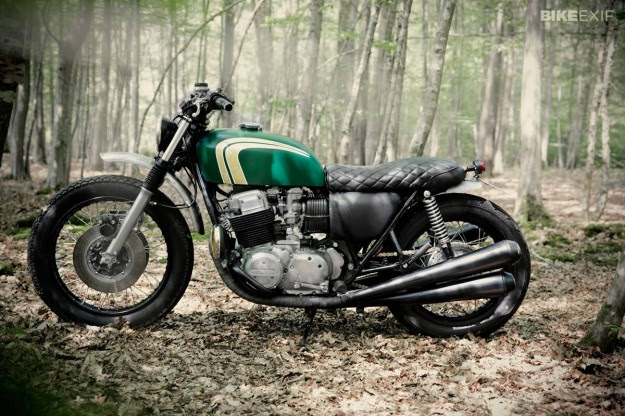
John’s a fan of the Japanese custom scene, so he wanted to add a touch
of Brat Style to the mix when rebuilding the bike. Fortunately the
engine was strong, and did not require a complete teardown. A light
‘refresh’ and rebuilt carbs had it running sweetly, and John resisted
the temptation to fit cone filters: “It rains around here.”
The CB750 tank was ditched in favor of a more compact CB450 unit,
which shows off the engine better. “I love it when you can see the
engine. It really is the heart of the bike.” John applied the paint
himself, and also the gold leaf striping. “It was difficult: gold leaf
is very volatile, and its handling requires precision and patience. I
had to make it twice.”
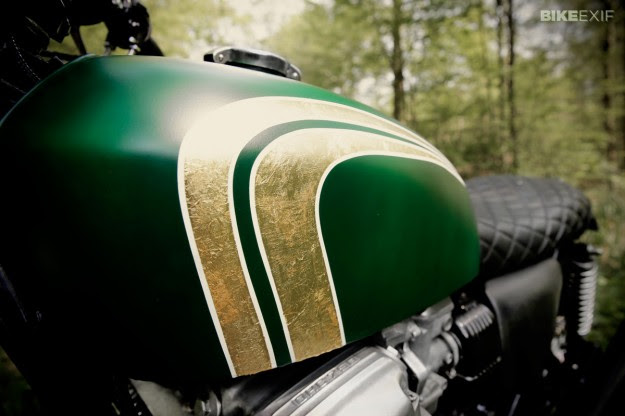
John also made a new seat pan, keeping it close to the frame to refine
the silhouette of the bike. The upholstery specialist BLG Sellerie then
shaped the foam and covered it with leatherette. The side covers were in
a bad way, so John had those covered in the same material.
John changed out the 17” rear wheel for an 18” item, to balance out
the 19” front a little better. He resisted the temptation to fit
Firestones: “I want the tires to grip, so there’s an Avon Speedmaster
MkII on the front and a Bridgestone Accolade AC04 at the back—a good
solution.”

The front fender didn’t quite look right, but there was no way John was
going to run without a fender. And he’s partial to riding on the
occasional forest track, as the images show. Raising the fender was the
solution, from both a practical and visual perspective.
The exhaust system, the visual signature of the CB750, was a tougher
nut to crack. The pipes were pierced with rust from inside and out, and
John decided repair them as best he could, removing what was left of the
baffles along the way and finishing them off with pipewrap. “I didn’t
want to wrap them at first,” he says, “But it became a win-win solution.
And the sound is just beautiful.”

The wiring loom was completely shot, so it was despatched and John hooked up new wiring to a Motogadget
M-unit. “This box is really amazing and made it possible to do a brand
new harness in a couple of hours. I also moved the ignition key to under
the right side cover, and fitted a Motogadget Motoscope Tiny
speedometer and turn signals at the front.”
The result is a revitalized CB750 K7 with an offbeat, quirky style,
like many of the customs coming out of Paris these days. “I’d define the
bike as a mix of Brat Style and scrambler,” says John. “So a kind of
‘Bratster’ I guess.”
Whatever it is, it sure looks good.
Images courtesy of Götz Göppert. Stay au fait with the French custom scene via the 4h10 Facebook page.
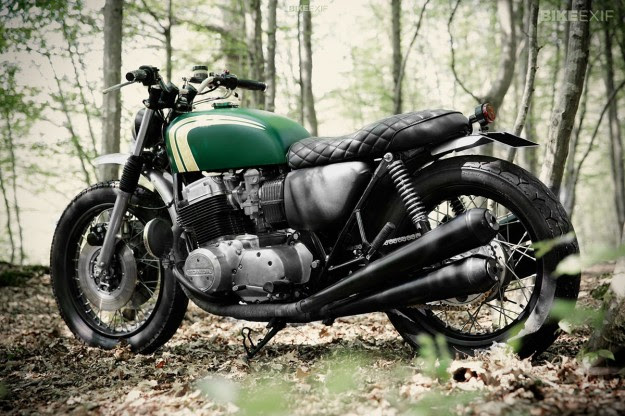 The post Honda CB750 K7 by 4h10 appeared first on Bike EXIF.
The post Honda CB750 K7 by 4h10 appeared first on Bike EXIF.
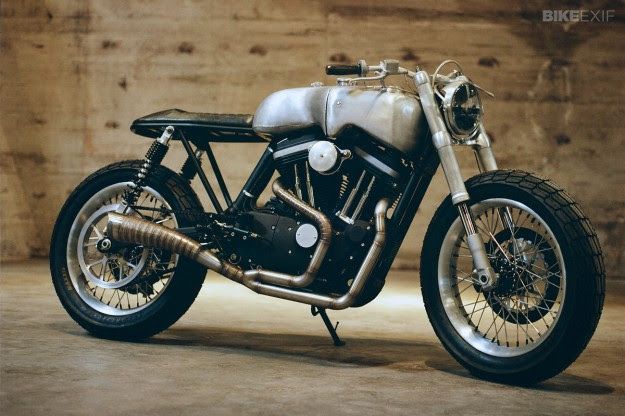
Revival Cycles are known mostly for their show-stopping Moto Guzzi
customs. So it should feel strange to see a Harley roll out of the Texas
workshop. But somehow, it doesn’t: this Sportster 883 is exactly what
you’d expect from Alan Stulberg and crew when it comes to style and
quality.
The story of ‘Hardley’ is a long one. The project kicked off over two
years ago when the 883′s owner spotted a few Revival builds floating
around. So he called up Stulberg and asked him if Revival would take on
his Harley. “Tony seemed adamant that we could turn it into something
special, and still a ‘Revival’ bike,” says Stulberg, “I’ll admit that I
had my doubts.”
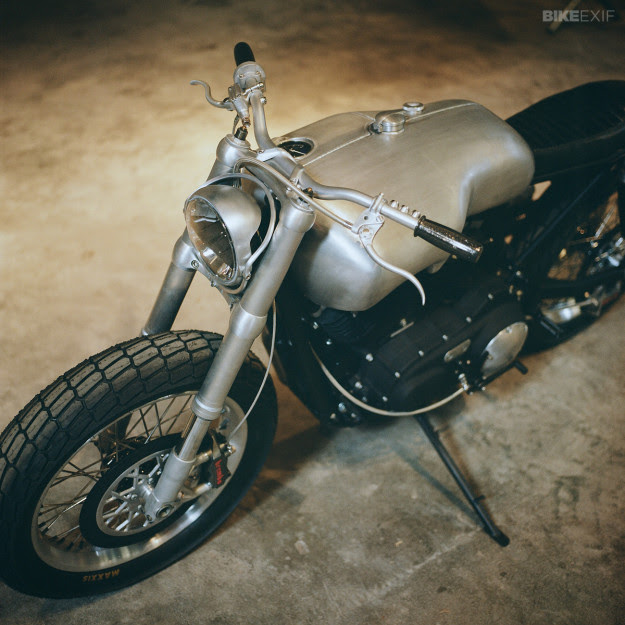
Tony offered free reign though, and this was enough to motivate Revival Cycles
to take on the build. “Just to see what we could do”. Revival decided
to focus on what they saw as the Harley’s biggest strength: its
heritage, defined by that big V-twin engine. Everything in the design
would serve to accentuate the V configuration: “As if everything else
was simply minimized to serve the engine shape,” says Stulberg. “If you
look hard enough, you’ll see the V shape on everything from the bespoke
handlebar clamp to the fuel tank profile that plunges into a V between
the cylinders.”
After stripping down the 883, Revival realised just how heavy the
stock bike was. Weight saving was not a priority, but the finished bike
weighs in at almost 102lbs less than stock. Custom 19” wheels were built
up and a new rear loop made to accommodate a café-style seat. And then
the project stalled—Tony decided that he wanted a two-up arrangement
instead. “A simple change of tank, seat and wheels ended up becoming an
entirely different animal,” says Stulberg.
“We felt inspired by just how far this bike could go if the budget,
timeline and limitations were thrown out the window. We pitched it to
Tony,” says Stulberg. “We wanted to build this machine into something
that would make us envious.” Tony agreed—but asked Revival to shelve the
bike until he’d had a chance to sort out other business.

Roughly a year later he returned with his pocketbook and planning began
anew. The 19” wheels would be kept, but a host of already-purchased
aftermarket parts were tossed, along with the Harley’s original
suspension. “This bike would now need proper suspension to match what
was coming.”
What was coming was a significant increase in power. “The 883 engine
numbers simply weren’t gonna cut it,” says Stulberg. Although the donor
bike only had 450 miles on it, Revival tore into it with a 1250cc
cylinder and piston kit, Harley’s own 1200cc heads (with larger valves
and ports) and an ECU with custom mapped fuel injection. The numbers are
much better now: 100bhp and 100Nm. “It’s wicked fast compared to how it
all began.”
Then Revival turned to this Sportster’s most distinguishing feature—a
completely bespoke, three-piece aluminum fuel tank. Built as a single
unit before being divided into three sections, it now carries three
gallons of fuel in the left half, with oil in the right rear quarter and
the electronics in the right front quarter. Fuel capacity is the same
as a stock Sportster 883, and the oil tank portion is double-walled to
keep it cool against the rider’s leg.

Revival know their way around a bike’s electrical system, and are devout users of Motogadget
products. The electronics section of the tank not only houses the
Motogadget Chronoclassic speedo, but also a Motogadget m-Unit electrical
system controller, a lithium-Ion battery and the ECU. “Plus about 98%
of the new made-from-scratch wiring harness,” Stulberg adds.
The space for the new electronics is about the same size as an
average motorcycle’s battery box, and significantly lighter than the
stock arrangement. As an added bonus, all three sections of the new
‘tank’ are easily removable via quick-turn fasteners.
Revival then wrapped the 19” wheels in popular Maxxis dirt-track
rubber. “They’re sticky as hell and will provide excellent traction on
any surface. They won’t last long, but we didn’t build this thing for
touring, we built it for serious abuse. And that means a tire
replacement now and then.”

The tyre and wheel choice influenced much of the remaining styling
considerations. For one, Revival wanted the bike to sit taller, with a
more aggressive stance. So they sourced stronger and taller upside-down
forks from a Kawasaki ZX-14, and matched them to custom-built shocks
from Ikon. Both the forks and shocks are fully adjustable. Revival
altered the geometry too—running simulations and calculations before
fabricating custom triple trees. The handlebar clamp is now integrated
into the top clamp: “It appears as if it was sculpted from one single
piece, as intended.”
For the braking system, Revival took the time to source new
technology pads that are made from an alloy and ceramic composite,
making them lighter and more resistant to brake fade. These were paired
with Brembo monobloc calipers and custom-built stainless steel brake
lines. Alan reports that the setup works well: “The intense feel and
control given from the combination of these brakes and the sticky tires
is simply amazing.”
The 883′s belt drive was retained. Revival mounted a blank rear
pulley, then CNC-milled it to match the shape of the rear brake rotor.
Belt tension became an issue though, due to the bike’s additional
suspension travel. So a custom spring-loaded idle arm was made, to ride
on the belt and keep it taut.

In keeping with the raw, hand-made feel of the rest of the bike, a full
stainless steel exhaust system was made up, including a custom-tuned
silencer with SuperTrapp internals. “This is a very quiet Harley at a stop light and as loud as any under full throttle.”
Revival also built a new, lightweight chromoly subframe, supporting a distressed leather seat made by Ginger at New Church Moto.
“Everything else on the bike was done in-house at Revival, but nobody
does leather work better than Ginger.” Undecided about the two-up seat,
Alan says that they’re “Likely going to build an easily removable second
seat that would have an aluminum cowl”. To this end, the passenger foot
pegs are removable.
Finishing kit includes a LED headlight in an aluminum housing, a LED
tail light embedded in the new subframe, rearsets by Sato, Posh grips
and new switchgear integrated into the handlebars.
Revival have succeeded in building a bike that’s not only beautiful
to look at, but loaded with technical features. And why the name
‘Hardley’?
Alan says it’s because it’s “hardly in the same league as its previous self.”
I couldn’t have put it better myself.
All images by Alan Stulberg, shot with a Hasselblad on medium format film. Keep in touch with Revival Cycles via their website or Facebook page. Our archive of previous Revival builds is here.
 The post Revival Cycles Harley Sportster 883 appeared first on Bike EXIF.
The post Revival Cycles Harley Sportster 883 appeared first on Bike EXIF.


















































